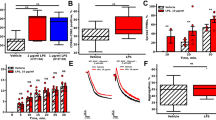Abstract
Platelets activated with physiological agonists, such as thrombin, ADP, or collagen, released products able to modulate neutrophil functions. In particular, platelet supernatant contained an inhibitor of superoxide anion generation induced by phorbol ester and a chemotactic factor for human neutrophils. The proteolytic digestion of platelet supernatant completely abrogated chemotactic activity without interfering with the inhibitory effect, indicating the presence of different molecules involved in the modulation of different neutrophil functions. This was further confirmed by the pretreatment of platelets with aromatic benzamidine which abolished chemotactic activity, but did not affect superoxide inhibition of neutrophils. This report provides evidence for interaction of platelets and inflammatory cells, suggesting that platelets are able to induce accumulation of neutrophils and control their respiratory burst, which also has a critical role in tissue damaging in inflammation.
Similar content being viewed by others
References
Klebanoff, S. J., andR. A. Clark. 1987. The neutrophil: Function and Clinical Disorders. Elsevier/North Holland Press, Amsterdam.
Gallin, J. I., I. M. Goldstein, andR. Snyderman. 1988. Inflammation. Basic Principles and Clinical Correlates. Raven Press, New York.
Gavioli, R., S. Spisani, A. L. Giuliani, andS. Traniello. 1987. Protein kinase C mediates human neutrophil cytotoxn city.Biochem. Biophys. Res. Commun. 148:1290–1294.
Klebanoff, S. J. 1982. Oxygen-dependent cytotoxic mechanism of phagocytes.In Advances in Host Defence Mechanisms, Vol. 1. J. I. Gallin and A. S. Fauci, editors. Raven Press, New York. 111–162.
Spitznagel, J. K., andW. M. Shafer. 1985. Neutrophil killing of bacteria by oxygen-independent mechanisms: A historical summary.Rev. Infect. Dis. 7:398–403.
Sacks, T., C. F. Maldow, P. R. Craddock, T. K. Bowers, andH. S. Jacob. 1978. Oxygen radicals mediate endothelial cell damage by complement-stimulated granulocytes. An in vitro model of immune vascular damage.J. Clin. Invest. 61:1161–1167.
Moon, D. G., H. van Der Zee, L. K. Weston, P. W. Gudewicz, J. W. Fenton II, andJ. E. Kaplan. 1990. Platelet modulation of neutrophil superoxide anion production.Thromb. Haemost. 63:91–96.
Dallegri, F., A. Ballestrero, L. Ottonello, andF. Patrone. 1989. Platelets as inhibitory cells in neutrophil-medtated cytolysis.J. Lab. Clin. Med. 114:502–504.
Dallegri, F., A. Ballestrero, L. Ottonello, andF. Patrone. 1989. Platelets as scavengers of neutrophil-derived oxid ants: A possible defence mechanism at sites of vascular injury.Thromb. Haemost. 61:415–418.
Wilson, E., S. M. Laster, L. R. Gooding, andJ. D. Lambeth. 1987. Platelet-derived growth factor stimulates phagocytosis and blocks agonist-induced activation of the neutrophil oxidative burst: A possible cellula:mechanism to protect against oxygen radical damage.Proc. Natl. Acad. Sci. U.S.A. 84:2213–2211.
Ferroni, R., E. Menegatti, M. Guarneri, U. Taddeo, M. Bolognesi, P. Ascenzi, A. Bertolini, andG. Amiconi. 1986. Aromatic tetra-amidines: Antiproteolytic and antiesterolytic activities towards serine proteinases involved in blood coagulation and clot lysis.Il Farmaco 41:464–470.
Milani, L., R. Ferroni, M. Zaccarini, andS. Traniello. 1989. Aromatic tetra-amidines with antiproteolytic activity inhibit platelet aggregation and secretion.Thromb. Res. 56:417–424.
Aoki, N., K. Naito, andN. Yoshida. 1978. Inhibition of platelet aggregation by protease inhibitor. Possible involvement of proteases in platelet aggregation.Blood 52:1–12.
Wilkinson, P. C. 1974. Outline a method for measuring chemotaxis.In Chemotaxis and Inflammation. P. C. Wilkinson (editor). Churchill Livingstone, Edinburgh.
Traniello, S., S. Spisani, R. Gavioli, L. Dovigo, O. R. Baricordi, A. Sensi, andG. Damiani. 1986. Deficiency of neutrophil membrane antigen detected by monoclonal antibody in rheumatoid arthritis.FEBS Lett. 204:449.
Zigmond, S. H., andJ. G. Hirsch. 1973. Leukocyte locomotion and chemotaxis: New methods for evaluation and demonstration of a cell derived chemotactic factor.J. Exp. Med. 137:387–410.
Spisani, S., T. Cavalletti, R. Gavioli, A. Scatturin, G. Vertuani, andS. Traniello. 1986. Response of human neutrophils to formyl-peptide modified at the terminal amino and carboxyl groups.Inflammiation 10:363–369.
Spisani, S., R. Gavioli, A. L. Giuliani, T. Cavalletti, M. Makastoni, G. Balboni, S. Salvadori, R. Tomatis, andS. Traniello. 1990. Chemotactic response of human monocytes to pentapeptide analog derived from immunodeficiency virus protein gp 120.Inflammation 14:55–60.
Spisani, S., R. Gavioli, P. Chiozzi, F. Lanza, F. Bortolotti, andS. Traniello. 1989. Lymphocytes treated with natural alpha-interferon produce a chemotatcic factor for human neutrophils.Cell Biol. Int. Rep. 13:163–169.
Traniello, S., P. Mantovani, R. Gavioli, R. Baricordi, A. Sensi, G. Damiani, andS. Spisani. 1988. Monoclonal antibodies: Modulation of cellular activities and identification of heterogeneity of functional response in human neutrophils.J. Clin. Lab. Immunol. 26:135–140.
Spisani, S., C. Marangoni, L. Dovigo, andS. Traniello. 1984. Effect of antiinflammatory agents on neutrophil superoxide production in rheumatoid arthritis.Inflammation 8:45–52.
Wong, S., J. R. Gamble, M. P. Skinner, C. M. Lucas, M. C. Berndt, andM. A. Vadas. 1991. Adhesion protein GMP 140 inhibits superoxide anion release by human neutrophils.Proc. Natl. Acad. Sci. U.S.A. 88:2397–2401.
Spisani, S., andS. Traniello. 1979. Effect of mediators of inflammation on human neutrophil motility.Adv. Inflamm. Res. 1:237–245.
Ward, P. A., T. W. Cunningham, K. K. McCulloch, andK. J. Johnson. 1988. Regulatory effects of adenosine and adenine nucleotides on oxygen radical responses of neutrophils.Lab. Invest. 58:438–447.
Cronstein, B. N., L. Daguma, D. Nichols, A. J. Htchinson, andM. Williams. 1990. The adenosine/neutrophil paradox resolved: Human neutrophils possess both A1 and A2 receptors that promote chemotaxis and inhibit O −2 · generation, respectively.J. Clin. Invest. 85:1150–1157.
Author information
Authors and Affiliations
Rights and permissions
About this article
Cite this article
Spisani, S., Giuliani, A.L., Cavalletti, T. et al. Modulation of neutrophil functions by activated platelet release factors. Inflammation 16, 147–158 (1992). https://doi.org/10.1007/BF00918954
Issue Date:
DOI: https://doi.org/10.1007/BF00918954




